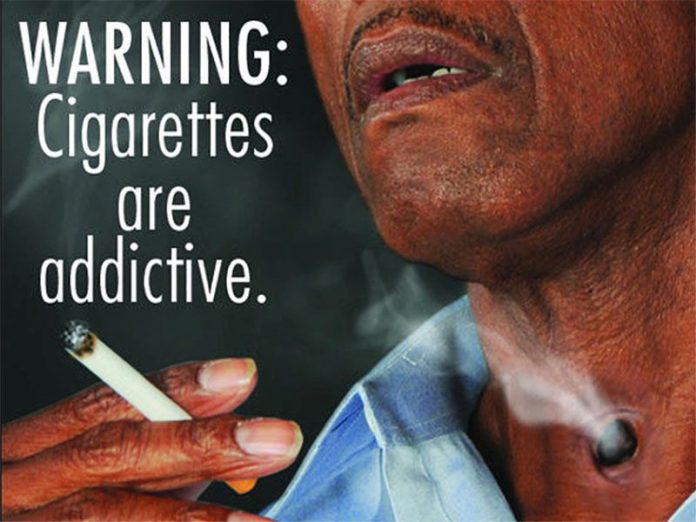FRIDAY, Nov. 4, 2016 (HealthDay News) — Graphically depicting the health consequences of smoking on U.S. cigarette packs would save more than 650,000 lives and prevent tens of thousands of preterm births and low birth weight babies by 2065, a new study suggests.
The analysis provides the first estimates of how American adults and infants would be affected by adding pictorial warnings to cigarette packs.
“By any standard, this would be considered a very, very successful public health intervention,” said study author David Levy. He is a professor of oncology at Georgetown University Medical Center in Washington, D.C.
An estimated 45 million U.S. adults smoke, accounting for nearly half a million preventable deaths and an estimated $300 billion in medical costs and productivity losses each year, according to the study authors’ background notes.
Yet warning labels depicting the physical toll of smoking have not been implemented in the United States, despite their effectiveness in other countries.
Tobacco industry litigation stalled a 2011 proposal to add such warnings to U.S. cigarette packs, the study authors noted. In 2012, the U.S. Circuit Court of Appeals for the District of Columbia found that the U.S. Food and Drug Administration‘s proposed rule violated tobacco companies’ First Amendment commercial speech rights.
Why the FDA hasn’t issued a new graphic warning rule is unclear, said Desmond Jenson, who follows the issue. Jenson is a staff attorney at the Public Health Law Center’s Tobacco Control Legal Consortium, which is based at the Mitchell Hamline School of Law in St. Paul, Minnesota.
“It is particularly perplexing given all of the evidence that has come out since the original rule was struck down,” he said.
Several public health groups recently filed a lawsuit asking a federal court to compel the FDA to issue a new rule, Jenson added.
The FDA does not comment on possible, pending or ongoing litigation, an agency spokesman said.
The U.S. Centers for Disease Control and Prevention has already incurred costs to study and develop warning labels, Levy said. Additional costs to the government would be minimal, he maintained.
Georgetown researchers and their colleagues at the University of Waterloo in Canada and the University of South Carolina did not calculate the cost to tobacco companies. (The Canadian author has served as a paid expert witness on behalf of governments in tobacco litigation. None of the other authors reported potential conflicts.)
The World Health Organization recommends pictorial warning labels that cover half or more of the front and back of cigarette packs. More than 70 countries have adopted or are considering such warnings, the study authors said.
The study authors examined the effects of pictorial warning labels on smoking rates in Australia, Canada and the United Kingdom to estimate the impact in America. Canada became the first country to adopt pictorial warnings in 2001.
Pictorial warning labels have had a significant impact on smoking rates in the studied countries, the investigators found. Eight years after Canada implemented the warnings, smoking prevalence fell by 12 percent to 20 percent compared to the period before those warnings were in effect. In the United Kingdom, smoking declined 10 percent the year after the warnings were introduced.
By modeling the would-be effects in the United States, the study authors projected a 5 percent reduction in smoking prevalence in the near term, increasing to 10 percent over time.
If the graphic warnings were put in place this year, the number of deaths due to smoking-related heart disease, lung cancer and chronic obstructive pulmonary disease would drop by an estimated 652,800 over 50 years, the researchers predicted.
By 2065, the warnings would avert more than 46,600 cases of low birth weight, 73,600 preterm births and 1,000 deaths due to sudden infant death syndrome (SIDS), the report indicated.
“The other countries have persisted and gotten the graphic warnings, so if they can do it, there’s no reason that the United States shouldn’t do it,” Levy said.
U.S. regulations requiring text-only warnings have remained unchanged since the 1980s, the study authors pointed out.
Altria Group Inc. is the parent company of tobacco giant Philip Morris USA.
According to Steve Callahan, a spokesman for Altria Client Services, the services and support unit of Altria Group, “If FDA were to propose a new rule for graphic health warnings, we would assess it at that time and provide our comments as part of the public comment process.”
The analysis was published online Nov. 3 in the journal Tobacco Control. It was funded by a grant from the U.S. National Institute on Drug Abuse and the U.S. National Cancer Institute.




